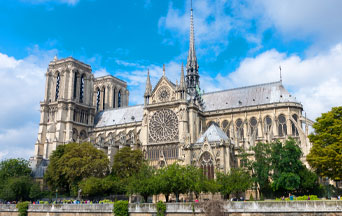
A recent article in The Guardian makes an exciting revelation—ninety-five percent of the donations for the restoration of Notre Dame come from Americans.
That was true even before the April 2019 fire.
In light of the devastating fire, it is easy to forget that Notre Dame was under restoration at the time. Two million dollars had been collected before the fire, and American donors have contributed another six million dollars since.
Why Notre Dame?
The Guardian article quotes Nathalie Dupont of Bucknell University. She cites two reasons for the size and number of these financial offerings. First, “A fascination for France has always existed in American culture.” Second, the United States has no medieval monuments compared to the monumental Parisian cathedral.
While there is much truth in Dr. Dupont’s observations, there must be something more to explain American generosity. The love of Notre Dame is not just a fad; it is something enduring that reveals the best of the American character.
Not the Biggest, Not the Oldest, but the Sublime
Notre Dame does not appeal because it is the oldest or largest of cathedrals.
Milan, for instance, has the Cathedral of the Nativity of Saint Mary, which is considerably larger. The fourth-century High Cathedral of Saint Paul in Trier, Germany, is far older. The latter holds the seamless garment for which the Roman soldiers drew lots after His death. Yet, none of these churches is as famous or loved as Notre Dame.
Eternal and Natural Law: The Foundation of Morals and Law
It is the sublime beauty that draws people to Notre Dame. Such considerations would not surprise Michael Whitcraft, a member of the American Society for the Defense of Tradition, Family and Property (TFP). The scholar has written on the nature of beauty. In a recent talk at the 2022 TFP National Conference, he pointed out that “Beauty has the capacity to operate on an almost instinctive level. It is not something that has to be thought out, analyzed or reflected on to do good to a soul.”
“Soul-Forming Effects”
Unfortunately, many practical-minded people overlook the importance of beauty. This attitude causes severe errors. Mr. Whitcraft continues, “just because beauty can act instinctively or automatically in the soul does not mean its effects are superficial. Quite the contrary. It can have life-altering and soul-forming effects.”
When beauty is absent, the soul feels the lack. In his article, “The Cult to Ugliness in America,” Father Anthony Brankin decried the trend toward plain, unadorned and banal church architecture.
“Now, you might think that at least on Sunday, you could be rescued from all of this visual and spiritual ugliness by going to church; but ugliness is there, too, for chances are that your church has already been despoiled by modern Catholic barbarians who haven’t even the artistic sense of the Unitarians who sit on your towns’ historic preservation boards.
 Learn All About the Prophecies of Our Lady of Good Success About Our Times
Learn All About the Prophecies of Our Lady of Good Success About Our Times
“The modernists will already have removed the tabernacle to a closet and the crucifix to the rectory basement. They will have torn up the sanctuary and torn down the shrines. They will have done their expensive best to ruin whatever vision of spiritual loveliness the first parishioners and the first architect possessed.”
Commonplace Buildings and Commonplace Liturgies
Father Brankin points out the connection between the uninspiring buildings and the commonplace liturgies celebrated within them. “But, again, you are so used to it by now that what they have done to your church in the name of reform barely registers anymore in your minds—at least not until you have to confront what they have also done to the Mass—ever-perky, ever-childish, ever-changing and ever-boring.”
Such devastation explains the attraction for the contrary. It is to America’s credit that generous souls seek out the most extreme expression of true architectural beauty found in Notre Dame. Every dollar contributed to Norte Dame is a vote against this deconstruction of church and liturgy. American Catholics do not want “worship spaces” that resemble Protestant chapels. They yearn for the sense of awe and majesty that one should feel in the Presence of God. In a broader sense, they desire the sublime.
To many in the modern world, the word sublime is unfamiliar. It is a faintly “old-fashioned” word often seen as merely a superlative form of nice.
Recovering the Sublime
In reality, sublime is a far more potent word. In his book Return to Order, John Horvat defines it as “of such excellence that it provokes a great emotion that causes one to be overawed by its magnificence or grandeur. The sublime might be found in extraordinary panoramas, works of art, ideas, virtuous acts or the heroic feats of men.”
Science Confirms: Angels Took the House of Our Lady of Nazareth to Loreto
One seldom encounters the sublime in modern-day life with its emphasis on vulgar and banal things. Given that the United States is a relatively new nation, Americans are more likely to spot the sublime in the natural world, such as in sites like the Grand Canyon.
Searching for the sublime in supernatural-inspired things often causes Americans to look to Europe. For instance, the sublime can be grasped in contemplating Michelangelo’s Pietà, which is so beautiful yet so painful at the same time. It can be found in ruins of Christendom that speak to the soul about God.
Notre Dame is one of the highest expressions of the sublime, which is why it must be restored to its pre-fire appearance and function. And that is why Americans give so generously to this great cause.
Photo Credit: © Ivan Nakonechnyy – stock.adobe.com

